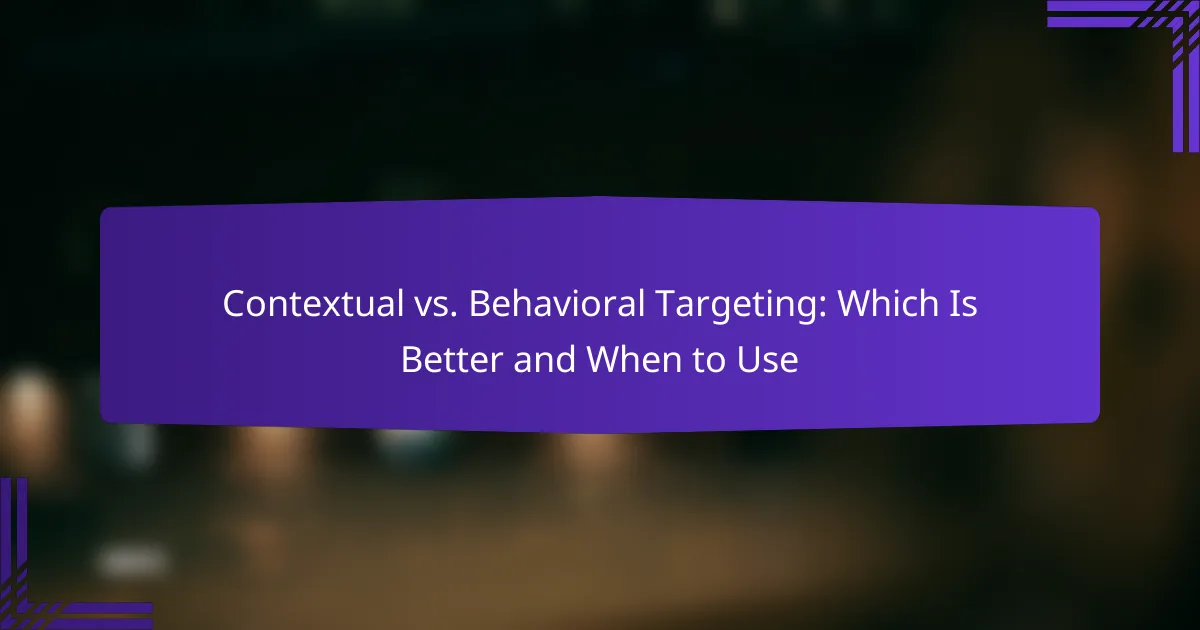In the realm of digital advertising, contextual and behavioral targeting serve distinct purposes, each with its own advantages. Contextual targeting focuses on aligning ads with the content of the webpage, making it effective for reaching audiences based on their immediate interests. Conversely, behavioral targeting leverages user data to deliver personalized ads based on past online behavior, allowing for tailored marketing messages. Understanding when to use each strategy can significantly enhance advertising effectiveness and user engagement.

What is contextual targeting?
Contextual targeting is a digital advertising strategy that focuses on displaying ads based on the content of the webpage where they appear. This method matches ads to relevant topics, ensuring that the advertising message aligns with the interests of the viewer at that moment.
Definition of contextual targeting
Contextual targeting involves analyzing the content of a webpage to determine the most appropriate ads to display. It relies on keywords, phrases, and themes present in the content, allowing advertisers to reach users based on their current interests rather than their past behavior.
How it works in display advertising
In display advertising, contextual targeting uses algorithms to scan the text, images, and overall theme of a webpage. Ads are then served based on this analysis, ensuring that they are relevant to the content being consumed. For instance, an article about healthy eating may display ads for organic food products.
Benefits of contextual targeting
One major benefit of contextual targeting is its ability to reach users when they are most receptive to related ads, potentially increasing engagement rates. Additionally, it respects user privacy since it does not rely on personal data or browsing history. This can lead to fewer privacy concerns and compliance with regulations such as GDPR.
Examples of contextual targeting platforms
Several platforms specialize in contextual targeting, providing tools for advertisers to implement this strategy effectively. Examples include Google Ads, which offers contextual targeting options through its Display Network, and Taboola, which focuses on content recommendations based on webpage content. Other platforms like Outbrain also provide similar services, allowing advertisers to reach audiences based on relevant content associations.

What is behavioral targeting?
Behavioral targeting is a marketing strategy that uses data on individuals’ online behavior to deliver personalized advertisements. By analyzing users’ past actions, such as browsing history and interactions, advertisers can tailor their messages to match specific interests and preferences.
Definition of behavioral targeting
Behavioral targeting involves tracking user behavior across websites and platforms to create a profile that reflects their interests. This method allows advertisers to serve relevant ads based on users’ previous online activities, increasing the likelihood of engagement and conversion.
How it works in display advertising
In display advertising, behavioral targeting relies on cookies and tracking pixels to gather data about users’ browsing habits. When a user visits a website, the tracking technology collects information about their actions, which is then analyzed to determine their preferences. Advertisers can then display ads that align with these interests on various platforms.
Benefits of behavioral targeting
Behavioral targeting offers several advantages, including improved ad relevance and higher conversion rates. By delivering personalized content, advertisers can engage users more effectively, leading to increased click-through rates. Additionally, this approach can enhance brand loyalty as users feel understood and catered to.
Examples of behavioral targeting platforms
Several platforms specialize in behavioral targeting, leveraging user data to optimize ad delivery. Notable examples include Google Ads, Facebook Ads, and AdRoll. These platforms utilize sophisticated algorithms to analyze user behavior and serve tailored advertisements across the web, maximizing the impact of marketing campaigns.

When to use contextual targeting?
Contextual targeting is most effective when advertisers want to reach audiences based on the content they are currently engaging with. This method leverages the context of web pages, ensuring ads are relevant to the surrounding material, which can enhance user experience and engagement.
Best scenarios for contextual targeting
Contextual targeting works best in environments where user intent is closely aligned with the content being consumed. For instance, placing ads for cooking utensils on a food blog can lead to higher engagement rates. It’s particularly useful for brand awareness campaigns where the goal is to reach users in specific content niches.
Additionally, contextual targeting is advantageous in industries with strict regulations on data privacy, as it does not rely on user data or tracking cookies. This makes it a compliant option for reaching audiences without infringing on privacy laws.
Industry examples favoring contextual targeting
Many industries benefit from contextual targeting, especially those heavily reliant on content relevance. For example, travel companies often advertise on travel blogs or websites that feature destination guides, ensuring that their ads reach users actively seeking travel information.
Similarly, the health and wellness sector frequently utilizes contextual targeting by placing ads for fitness products on health-related articles. This strategy not only improves click-through rates but also fosters a sense of trust and relevance among potential customers.

When to use behavioral targeting?
Behavioral targeting is most effective when you want to reach users based on their past online behavior, such as browsing history and interactions with ads. This approach helps tailor marketing messages to individuals, increasing the likelihood of engagement and conversion.
Best scenarios for behavioral targeting
Behavioral targeting works best in scenarios where you have access to rich data on user interactions, such as e-commerce sites or content platforms. For example, if a user frequently visits pages about fitness, targeting them with related products or services can yield better results.
Additionally, campaigns that aim to retarget users who have previously shown interest in specific products or services can benefit greatly from behavioral targeting. This strategy keeps your brand top-of-mind and encourages users to return and complete their purchases.
Industry examples favoring behavioral targeting
In the retail industry, companies like Amazon utilize behavioral targeting to recommend products based on users’ browsing and purchasing history. This personalized approach often leads to increased sales and customer satisfaction.
Similarly, in the travel sector, platforms like Expedia leverage behavioral targeting by showing users tailored travel deals based on their previous searches and bookings. This not only enhances user experience but also drives higher conversion rates.

How do contextual and behavioral targeting compare?
Contextual targeting focuses on displaying ads based on the content of the webpage, while behavioral targeting uses user data and past behavior to deliver personalized ads. Both methods have distinct advantages and can be effective depending on the campaign goals and audience characteristics.
Key differences between targeting methods
Contextual targeting analyzes the context of the content to determine ad placement, ensuring relevance based on the current page’s subject matter. This method does not rely on user data, making it compliant with privacy regulations like GDPR.
In contrast, behavioral targeting tracks user actions across the web, utilizing cookies and browsing history to tailor ads to individual preferences. This approach can lead to higher engagement rates but raises privacy concerns and may require user consent.
Cost-effectiveness comparison
Contextual targeting often has lower upfront costs since it does not require extensive data collection or analysis. Advertisers can expect to see a good return on investment when targeting niche content areas, especially in markets with less competition.
Behavioral targeting, while potentially more expensive due to data acquisition and analysis, can yield higher conversion rates. The cost-effectiveness of this method often depends on the quality of the data used and the sophistication of the targeting algorithms.
Audience engagement metrics
Engagement metrics for contextual targeting typically include click-through rates (CTR) and impressions, which can be favorable when ads align well with the content. However, the engagement may be lower compared to behavioral targeting since it lacks personalization.
Behavioral targeting generally results in higher engagement metrics, such as longer time spent on site and increased conversion rates, due to its personalized approach. Advertisers should monitor these metrics closely to optimize campaigns and adjust strategies based on audience responses.

What are the prerequisites for choosing a targeting method?
Choosing a targeting method requires a clear understanding of your audience, budget, and campaign goals. Contextual targeting focuses on the content being viewed, while behavioral targeting relies on user data and past behavior, making the decision dependent on specific marketing objectives.
Understanding audience demographics
Audience demographics play a crucial role in selecting a targeting method. Factors such as age, gender, location, and interests can influence how effectively your message resonates with potential customers. For instance, if your product appeals to a younger demographic, behavioral targeting may yield better results due to its focus on user engagement patterns.
Consider segmenting your audience based on these demographics to tailor your approach. Tools like Google Analytics can provide insights into who is visiting your site, helping you refine your targeting strategy.
Budget considerations for targeting
Your budget significantly impacts the choice between contextual and behavioral targeting. Contextual targeting often requires less upfront investment, as it relies on placing ads alongside relevant content. In contrast, behavioral targeting may demand a higher budget for data acquisition and analysis but can lead to more personalized and effective campaigns.
Evaluate your financial resources and desired return on investment (ROI) when deciding. If your budget is limited, starting with contextual targeting can be a cost-effective way to reach your audience without extensive data collection.
